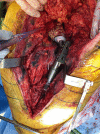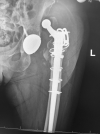Dual Mobility in Total Hip Arthroplasty: Biomechanics, Indications and Complications-Current Concepts
- PMID: 34824721
- PMCID: PMC8586128
- DOI: 10.1007/s43465-021-00471-w
Dual Mobility in Total Hip Arthroplasty: Biomechanics, Indications and Complications-Current Concepts
Abstract
Dual-mobility (DM) articulations are increasingly utilized to prevent or manage hip instability after total hip arthroplasty (THA). DM cups offer enhanced stability due to the dual articulation resulting in larger jump distance and greater range of motion before impingement. Improvement in design features and biomaterials has contributed to increased interest in dual-mobility articulations due to lower risk of complications compared to their historic rates. The incidence of implant-specific complications like intra-prosthetic dislocation (IPD) and wear has reduced with newer-generation implants. DM THAs are used in primary THA in patients with high risk for dislocation, e.g. neuromuscular disorder, femoral neck fracture, spinopelvic deformity, etc. They offer an attractive alternative option to constrained liner for treatment of hip instability in revision THA. The medium- to short-term results with DM THA have been encouraging in primary and revision THA. However, there are concerns of fretting, corrosion and long-term survivorship with DM THA. Hence, longer-term studies and surveillance are required for the safe use of DM THA in clinical practice.
Keywords: Complications; Dual-mobility; Instability; Total hip arthroplasty.
© Indian Orthopaedics Association 2021.
Conflict of interest statement
Conflict of interestThe authors declare that they have no conflict of interest.
Figures






Similar articles
-
Dual Mobility Acetabular Cups in Primary Total Hip Arthroplasty in Patients at High Risk for Dislocation.Surg Technol Int. 2017 Jul 25;30:251-258. Surg Technol Int. 2017. PMID: 28395391
-
Dual mobility in primary total hip arthroplasty: A temptation from the devil or a blessing from above.World J Orthop. 2024 Jun 18;15(6):512-519. doi: 10.5312/wjo.v15.i6.512. eCollection 2024 Jun 18. World J Orthop. 2024. PMID: 38947268 Free PMC article. Review.
-
Low Frequency of Early Complications With Dual-mobility Acetabular Cups in Cementless Primary THA.Clin Orthop Relat Res. 2016 Oct;474(10):2181-7. doi: 10.1007/s11999-016-4811-6. Clin Orthop Relat Res. 2016. PMID: 27106128 Free PMC article.
-
Intraprosthetic Dislocation of Dual-Mobility Total Hip Arthroplasty: The Unforeseen Complication.Cureus. 2021 Nov 24;13(11):e19858. doi: 10.7759/cureus.19858. eCollection 2021 Nov. Cureus. 2021. PMID: 34963863 Free PMC article. Review.
-
Revision total hip arthroplasty with a Kerboull plate: comparative outcomes using standard versus dual mobility cups.Int Orthop. 2019 Oct;43(10):2245-2251. doi: 10.1007/s00264-018-4209-z. Epub 2018 Oct 29. Int Orthop. 2019. PMID: 30370452
Cited by
-
Evaluating the Effectiveness of Conventional Prostheses Against Dual-Mobility Prostheses in the Treatment of Femoral Neck Fractures in Two Separate Groups of Patients: A Clinical Trial Study.Adv Biomed Res. 2023 Sep 27;12:228. doi: 10.4103/abr.abr_108_23. eCollection 2023. Adv Biomed Res. 2023. PMID: 38073750 Free PMC article.
-
Outcomes of total hip arthroplasty using dual mobility cups following failed internal fixation of proximal femoral fractures at a mean follow-up of 6 years.SICOT J. 2024;10:3. doi: 10.1051/sicotj/2023038. Epub 2024 Jan 18. SICOT J. 2024. PMID: 38240729 Free PMC article.
-
Pelvic flexion/extension and its impact on functional acetabular alignment and stability following total hip replacement.Int Orthop. 2024 Apr;48(4):1039-1047. doi: 10.1007/s00264-023-06060-w. Epub 2023 Dec 19. Int Orthop. 2024. PMID: 38110775 Free PMC article.
-
Is Cemented Dual-Mobility Cup a Reliable Option in Primary and Revision Total Hip Arthroplasty: A Systematic Review.J Pers Med. 2022 Dec 29;13(1):81. doi: 10.3390/jpm13010081. J Pers Med. 2022. PMID: 36675742 Free PMC article. Review.
-
Are There Benefits of Total Hip Arthroplasty with Dual-Mobility Cups Compared to Bipolar Hemiarthroplasty for Femoral Neck Fractures in the Geriatric Population? A Systematic Review and Meta-Analysis of Comparative Studies.J Clin Med. 2025 Jul 17;14(14):5076. doi: 10.3390/jcm14145076. J Clin Med. 2025. PMID: 40725766 Free PMC article. Review.
References
-
- Gilson M, Gossec L, Mariette X, Gheriss D, Guyot MH, Berthelot JM. NIH consensus conference: total hip replacement. NIH consensus development panel on total hip replacement. The Journal of the American Medical Association. 1995;273(24):1950–1956. doi: 10.1001/jama.1995.03520480070043. - DOI - PubMed
-
- Romagnoli M, Grassi A, Costa GG, Lazaro LE, Presti ML, Zaffagnini S. The efficacy of dual-mobility cup in preventing dislocation after total hip arthroplasty: A systematic review and meta-analysis of comparative studies. International Orthopaedics. 2019;43(5):1071–1082. doi: 10.1007/s00264-018-4062-0. - DOI - PubMed
Publication types
LinkOut - more resources
Full Text Sources
